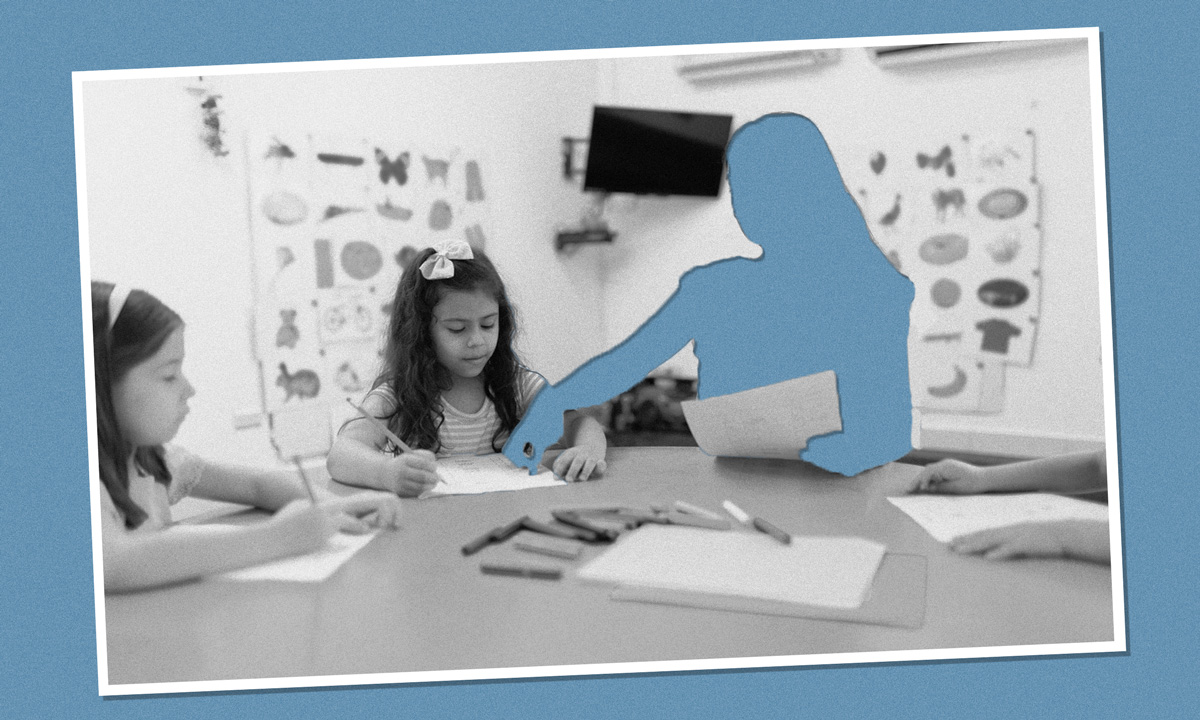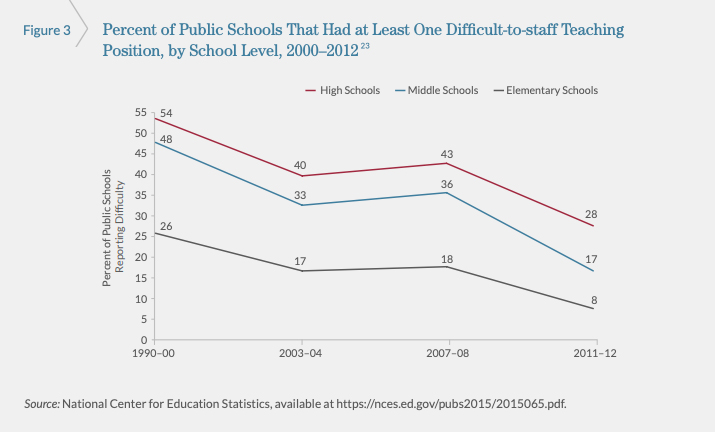Yes, There’s a Shortage of Special Education Teachers. And That’s Nothing New
Schools scramble to fill special ed slots with bonuses & incentives. But, says one advocate, 'that's kind of a Band-Aid on a bullet hole'

Get stories like this delivered straight to your inbox. Sign up for The 74 Newsletter
For all the headlines proclaiming and debunking reports of a national teacher shortage, few have picked up on the issue’s third rail: Educators qualified to teach students with disabilities have been in short supply for half a century — since, essentially, the creation of special education.
There are numerous reasons why special educators are in perennially short supply, as well as evidence that strategies to increase their ranks are within reach. But those efforts will remain scattershot so long as special education’s second-class status persists, say disability advocates.
“It’s a part of a continuum of special education being treated as secondary,” says Lauren Morando Rhim, executive director of the Center for Learner Equity, which advocates for children with disabilities. “All teachers work hard, but absent a sense of being part of a community, or considered central to the community, the paperwork burden and the challenges of their job just make it unfulfilling and unsustainable” to teach special ed.
The problems, she and other advocates say, affect virtually every aspect of special education staffing. There are few policies prodding colleges of education to graduate more candidates, a dearth of incentives for those newly minted teachers to go to work instructing children with disabilities and too little support to keep them in those positions.
Depending on the rules in their state, special educators must do more — earn more college credits, take on more student debt, perform more work — than general education teachers, while getting the same or fewer resources. While some districts have begun offering higher pay, only a handful have increased financial incentives enough to begin filling special ed vacancies.
While quantifying teacher shortages was a tricky business even before the pandemic, the nationwide lack of special ed teachers has long been clear. On average, between 1998 and 2018, 80% of states reported special education shortages, while overall education vacancies skew heavily in just nine states.
In a 2019 report, the education consultancy Bellwether cautioned that what is frequently described as a teacher shortage is actually a mismatch between schools’ needs and the kinds of graduates colleges of education are turning out. In the 2011-12 school year, for example, 2% of schools reported struggling to find general elementary teachers, while 17% couldn’t find enough special educators. Similar shortages persist in math and biology and life sciences.

By way of illustration, the report notes that for every 12 social studies licenses issued in Illinois, one teacher was hired in the state. In contrast, two of every three special educators found work.
The Individuals with Disabilities in Education Act of 1973 does not allow school systems to use a shortage of qualified educators to justify denying students with learning differences the services they need to succeed. One reason for this requirement is to push districts to prioritize this vulnerable subset of children. But in practice, in the half-century since the law’s passage, advocates say, pressure needed to prime the special educator pipeline has failed to materialize.
Here are some of the obstacles they have identified, as well as which promising practices might help.
The Current Moment
Within days of the first COVID school closures, controversies erupted over serving students with disabilities. District administrators protested that moving special education online was impossible; federal officials countered that the pandemic was no reason for inaction. But in practice, many children went for months, and in some cases years, without crucial help.
Those kids are legally entitled to extra help to catch up, putting pressure on school systems to hire enough educators and support staff to meet their needs. Adding to the crunch: Disability advocates expect the number of students receiving special education services to skyrocket, as children overdue to be evaluated receive diagnoses and many who fell far behind are referred for assessment.
To meet these needs, districts are using some of their billions in federal pandemic recovery funds to beef up staffing, creating intense competition for talent. Special education classroom aides are in particularly short supply.
Some districts are filling in by placing subs or educators without proper credentials in classrooms for children with disabilities. Not only are unqualified teachers less likely to help students recover from the interruptions of the last three school years, they are more likely to quit — both factors that compound the problem.
The most recent hard data on teaching jobs is from the 2019-20 school year, the pandemic’s first, and does not reveal an uptick in resignations. But there is evidence that in general, turnover is higher among special education teachers than others. One study found that between the 2015-16 and 2016-17 school years, special educators were 11% more likely to leave the classroom and 72% more likely to change schools than general education teachers.
Because of the difficulties of remote learning and COVID’s brutal impact on student well-being, the factors that are thought to drive turnover among special educators likely compounded during the pandemic, which may have driven resignations and retirements that have yet to show up in official statistics.
Research from Rand on educator perceptions of the 2020-21 school year found teachers of students with disabilities particularly stressed. Many reported they did not get adequate support or guidance on remote instruction and had no idea whether they were communicating effectively with pupils, who were disengaged.
The Pipeline
For 20 years, federal officials have asked states to report teacher shortages but have never required it. As a result, while policymakers are aware that a lack of special educators is an ongoing problem, in many places, they do little to address it.
“The misalignment between teacher supply and demand is where the teacher shortage crisis is born and lives,” Bellwether reported, citing a “misinformed narrative about generalized teacher shortages” as part of the problem. “It leads policymakers to create broad rather than targeted solutions to acute problems.”
The first hurdle is persuading education college students to take a longer path to the classroom. In many places, earning a special education license is harder and more expensive than becoming certified in other areas — a challenge many college students won’t take on.
“It’s a tougher road,” says Mayme Hostetter, president of the Relay Graduate School of Education, which offers programs that seek to eliminate hurdles for prospective special educators. “It’s a longer, harder and generally more expensive certification process. You’re not better paid. There’s no recompense.”
From 2013 to 2018, the percentage of potential new teachers seeking special education licenses has hovered near 17%. Few states push colleges of education to find ways to smooth the path to special education licensure.
Also contributing to the shortfall: Not all of those newly minted special education teachers end up serving students with disabilities. Teachers with dual certification — both special and general education credentials — are 20% less likely to be placed in a special education role than special educators alone, according to a 2020 report from the American Institutes of Research’s Calder Center.
Finding ways to entice dual-licensed teachers to accept special education roles is one step struggling districts should consider, say labor market analysts.
One example: Heading into the new school year, Montgomery County Public Schools, in Maryland, had more than 2,800 dual-certified teachers — and over 100 unfilled special education jobs. In August, the district offered a $5,000 incentive to any employee teaching in general education but holding a special education license to transfer to a vacant special ed position.
If they are large enough, such financial enticements show promise, according to the National Council on Teacher Quality. In 2020, Hawaii began paying special education teachers $10,000 more than their peers. In one year, it cut its shortage in half, drawing 300 new special educators to its classrooms.
Detroit Public Schools Community District began offering a $15,000-a-year incentive to special educators in the 2021-22 school year. Dual-licensed teachers employed by the district in general education are eligible for the pay boost if they switch classrooms.
Pre-pandemic, Atlanta filled all its vacancies within a month of offering new special education teachers $3,000 bonuses. In 2021, it began offering the incentives to all teachers of students with disabilities.
There is pushback to the idea of differentiated pay, says Chad Aldeman, policy director of the Edunomics Lab at Georgetown University. “Historically, unions have opposed offering special incentives for teachers who work in shortage areas or hard-to-staff schools,” he says. “We as a country have treated teachers universally and not said, ‘This person has a harder job.’ ”
Administrators also often say they can’t afford to pay special educators more, especially because, for decades, Congress and states have failed to fund the system at promised levels. To this, Aldeman counters that there are also expenses associated with teacher turnover.
“The cost to replace a teacher is higher than $10,000 a year,” he says. “If districts invest in their current employees, they will save money along the way.”
Morando Rhim agrees, but cautions that without changing the culture of special education in many schools, the churn will continue.
“I feel like that’s kind of a Band-Aid on a bullet hole,” she says. “You might be able to entice teachers by offering more, but if you don’t address the underlying problems of special ed teachers feeling like second-class citizens, we’re never going to address the challenge in a sustainable way.”
Disability advocates have long complained that in most schools, special education exists in a silo — a reference both to the likelihood that students are segregated within their school and that their teachers are not fully integrated into the staff. Often, administrators don’t understand their jobs or know what their needs are. Their extra expertise and longer hours can be invisible to co-workers.
Often, general education teachers see special ed classrooms as a place where they can send a student who is struggling academically or behaviorally, reinforcing the notion that disabled kids are the responsibility not of the entire school, but of a subset of teachers trained to manage them.
“A culture of shared responsibility … has been tied to better working conditions for special educators and an increased likelihood that special educators will remain in their schools,” Rand reported last year. “Schools must undergo substantial ‘re-culturing,’ including changes in teachers’ beliefs about student learning, priorities and norms of teacher interaction.”
Perennial tension exists between disability advocates and education leaders about the value of inclusion, the practice of integrating children with exceptional needs into regular classrooms as much as possible. The law entitles students receiving special education services to qualified teachers and the same level of academic challenge as their peers, when appropriate.
Advocates have long argued that it is more effective, and thus less costly in the long run, to make classrooms as inclusive as possible. But even as districts tout inclusion as a priority, efficiency-seeking administrators often default to segregating special educators and their students.
There are warning signs that coming out of the pandemic, schools are using staffing shortages to justify reducing legally required services. Minnesota’s largest school system, Anoka-Hennepin Public Schools, has announced the closure of its standalone facility for students with behavioral issues that require a segregated setting.
The neighboring Minneapolis district — unilaterally, and contrary to federal law — moved several hundred students needing intensive services from in person to online over the summer. That in-person program had been promised to help make up deficits from online learning during COVID. In the days before the new school year was to start, some families also complained that mandated services such as specialized transportation have been eliminated.
“You’re robbing Peter to pay Paul,” Morando Rhim warns. “Kids don’t just sit in classrooms when they don’t learn. They start to have behavior problems. They start to not want to attend school.”
Possibilities
Founded in 1967 to help students with disabilities, their parents and teachers, the Learning Disabilities Association of Minnesota has long employed educators and trained them to close gaps in literacy, tutor students who aren’t getting enough help in school and perform a host of other tasks. In 2018, when the state agreed to allow organizations that aren’t traditional colleges of education to begin training teachers, creating a special education licensure program was a no-brainer, says Executive Director Martha Moriarty.
“Every single family that comes to us has a problem with the special education system,” she says. “Special education is a pipeline to prison for many kids.”
In early September,, the association welcomed seven would-be teachers. For 21 months, members of the small group — all college graduates — will take in-person classes at night, work one-on-one with skilled mentors and hone their skills in a classroom residency. Graduates will qualify for an Academic and Behavioral Specialist license, enabling them to work with students in any grade with a number of disabilities — a flexibility especially sought-after by schools. The goal is to eventually train 20 teachers per year.
Like other alternative licensure programs, Moriarty’s recruits people of color who are frequently special education classroom aides. Because the job pays as little as $15 an hour, many can’t afford another degree. But educational assistants often share their students’ backgrounds, which makes them uniquely suited for the challenges of special education.
“We find that people who have had their own struggles identify with their students and want to be part of this,” Moriarty says. “For them, a college campus is not necessarily as welcoming as a small nonprofit.”
Still, because the training is offered not by a university but by a social service agency, students are not eligible for federal financial aid to help cover the $16,000 cost. And as the number of alternative licensure programs has grown, the small pot of state funding lawmakers agreed to when they changed the law has not kept pace, throwing up a new hurdle to increasing the number of people who can become special educators.
The association offers candidates of color a discount, and local charter schools often subsidize tuition for employees looking to move up, to address their own special ed staffing issues. But overall, sustainable funding is elusive.
To Morando Rhim, this is more evidence that the real cause of the special educator shortage is persistent apathy among policymakers at every level.
“This has been a problem for years that we didn’t pay attention to,” she says. “I don’t think special education is functional right now, in either charter schools or district schools. We don’t approach it as a place where we want to include all kids.”
Disclosure: Walton Family Foundation and the Bill & Melinda Gates Foundation provide financial support to Georgetown University’s Edunomics Lab, the National Council on Teacher Quality, the Center for Learner Equity and The 74. The Bill & Melinda Gates Foundation provided financial support for research at the American Institutes for Research’s Calder Center and Rand. The Joyce Foundation provides financial support to the National Council on Teacher Quality and The 74. Andy Rotherham co-founded Bellwether. He sits on The 74’s board of directors.
Get stories like these delivered straight to your inbox. Sign up for The 74 Newsletter

;)
